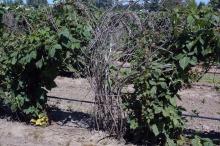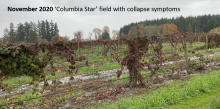Cause Blackberry collapse has appeared in commercial 'Columbia Star' and 'Black Diamond' fields in the Willamette Valley of Oregon. Other names for this disease may include "cane wilt and canker". The fungus Gnomoniopsis idaeicola has been associated with these collapsed plants but can be confused with other diseases such as those caused by Kalmusia coniothyrium (the cane blight pathogen) and Botrytis sp. Necrosis was largest on canes inoculated with G. idaeicola. This same pathogen has been found on wild Rubus spp. in the Pacific Northwest. Losses in Serbia have been high on the cultivar Loch Ness and on cultivars grown in Iran.
Symptoms The main symptom is a sudden wilting and death of entire plants in semi-circular patches in the field. In these areas there is general weakness of plants having fewer and shorter primocanes, floricane reddening, and premature floricane senescence. There may be irregular lesions on the canes which may be brown or purplish. Also, there may be necrosis at the clasping end of a petiole and death of nearby buds. Sunburn may also be observed on affected plants.
Cultural control
- Remove symptomatic plants.
Reference Stockwell, V. O. and Shaffer, B. T. 2024. Multiplex PCR Assay for Detection and Identification of Gnomoniopsis idaeicola, the Causal Agent of Blackberry Collapse. Plant Health Progress, 25:214-217.


